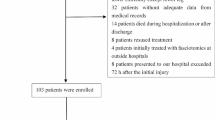Abstract
Introduction
The primary objective of this study is to determine whether time from injury to fasciotomy is associated with increased risk for death or limb amputation in patients with acute leg compartment syndrome. The secondary objective of this study is to identify other risk factors for death or limb amputation in patients with acute leg compartment syndrome.
Methods
In an institutional review board approved retrospective study, we identified 546 patients with acute compartment syndrome of 558 legs treated with fasciotomies from January 2000 to June 2015 at two Level I trauma centers. Our primary outcome measures were death and limb amputation during inpatient hospital admission. Electronic medical records were analyzed for patient-related factors and treatment-related factors. Bivariate analyses were used to screen for variables associated with our primary outcome measures, and explanatory variables with a p value below 0.05 were included in our multivariable logistic regression analyses.
Results
In-hospital death occurred in 6.6% and in-hospital limb amputation occurred in 9.5% of acute leg compartment syndrome patients. Neither death nor limb amputation was found to be associated with time from injury to fasciotomy. Multivariable logistic regression analyses showed that older age (p = 0.03), higher modified Charlson Comorbidity Index (p = 0.009), higher potassium (p = 0.02), lower hemoglobin (p = 0.002), and higher lactate (p < 0.001) were associated with death, and diabetes mellitus (p = 0.05), no compartment pressure measurement (p = 0.009), higher PTT (p = 0.03), and lower albumin (p = 0.01) were associated with limb amputation.
Conclusions
Time to fasciotomy is not found to be associated with death or limb amputation in acute leg compartment syndrome. Death and limb amputation are associated with patient-related factors and injury severity.
Level of evidence
Level III Prognostic.
Similar content being viewed by others
References
Prasarn ML, Ouellette EA (2011) Acute compartment syndrome of the upper extremity. J Am Acad Orthop Surg 19(1):49–58
McQueen MM, Gaston P, Court-Brown CM (2000) Acute compartment syndrome. Who is at risk? J Bone Jt Surg Br 82:200–203
Rorabeck CH (1984) The treatment of compartment syndromes of the leg. J Bone Jt Surg Br 66(1):93–97
von Keudell AG, Weaver MJ, Appleton PT, Bae DS, Dyer GS, Heng M et al (2015) Diagnosis and treatment of acute extremity compartment syndrome. Lancet 386(10000):1299–1310
Bodansky D, Doorgakant A, Alsousou J, Iqbal HJ, Fischer B, Scicluna G et al (2018) Acute compartment syndrome: do guidelines for diagnosis and management make a difference? Injury 49(9):1699–1702
Jensen SL, Sandermann J (1997) Compartment syndrome and fasciotomy in vascular surgery. A review of 57 cases. Eur J Vasc Endovasc Surg 13(1):48–53
Rush DS, Frame SB, Bell RM, Berg EE, Kerstein MD, Haynes JL (1989) Does open fasciotomy contribute to morbidity and mortality after acute lower extremity ischemia and revascularization? J Vasc Surg 10(3):343–350
Bryant D, Havey TC, Roberts R, Guyatt G (2006) How many patients? How many limbs? Analysis of patients or limbs in the orthopaedic literature: a systematic review. J Bone Jt Surg Am 88(1):41–45
Duckworth AD, Mitchell SE, Molyneux SG, White TO, Court-Brown CM, McQueen MM (2012) Acute compartment syndrome of the forearm. J Bone Jt Surg Am 94:e63
Fisher A, Fisher L, Srikusalanukul W, Smith PN (2018) Usefulness of simple biomarkers at admission as independent indicators and predictors of in-hospital mortality in older hip fracture patients. Injury 49(4):829–840
Herron J, Hutchinson R, Lecky F, Bouamra O, Edwards A, Woodford M et al (2017) The impact of age on major orthopaedic trauma: an analysis of the United Kingdom Trauma Audit Research Network database. Bone Jt J 99(12):1677–1680
Keil DS, Gross S, Seymour RB, Sims S, Karunakar MA (2018) Mortality after high-energy pelvic fractures in patients of age 65 years or older. J Orthop Trauma 32(3):124–128
da Costa LGV, Carmona MJC, Malbouisson LM, Rizoli S, Rocha-Filho JA, Cardoso RG et al (2017) Independent early predictors of mortality in polytrauma patients: a prospective, observational, longitudinal study. Clin (Sao Paulo) 72(8):461–468
Dekker SE, de Vries HM, Lubbers WD, van de Ven PM, Toor EJ, Bloemers FW et al (2017) Lactate clearance metrics are not superior to initial lactate in predicting mortality in trauma. Eur J Trauma Emerg Surg 43(6):841–851
Negrin LL, Antoni A, Hajdu S, Heinz T (2018) A novel approach to identify polytraumatized patients in extremis. Biomed Res Int 2018:7320158
Yadollahi M, Rahmanian N, Jamali K (2018) Analysis of risk factors with hospital mortality in pedestrian injured patients; a dataset analysis of a Level-I Trauma Center in Southern Iran. Bull Emerg Trauma 6(4):349–354
Chang R, Cardenas JC, Wade CE, Holcomb JB (2016) Advances in the understanding of trauma-induced coagulopathy. Blood 128(8):1043–1049
Author information
Authors and Affiliations
Corresponding author
Ethics declarations
Conflict of interest
The authors declare that they have no competing interests
Ethical approval
This article does is a retrospective study of human clinical data performed with institutional review board approval, and have therefore been performed in accordance with the ethical standards laid down in the 1964 Declaration of Helsinki and its later amendments.
Additional information
Publisher's Note
Springer Nature remains neutral with regard to jurisdictional claims in published maps and institutional affiliations.
Rights and permissions
About this article
Cite this article
Zhang, D., Janssen, S.J., Tarabochia, M. et al. Risk factors for death and amputation in acute leg compartment syndrome. Eur J Orthop Surg Traumatol 30, 359–365 (2020). https://doi.org/10.1007/s00590-019-02563-8
Received:
Accepted:
Published:
Issue Date:
DOI: https://doi.org/10.1007/s00590-019-02563-8



